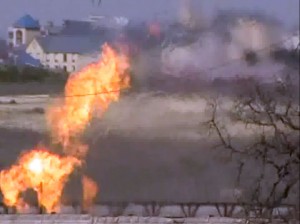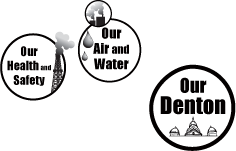Dentonites need some facts about the air pollutants detected in their neighborhoods during fracking. Below are three examples
 Razor Ranch Unit near McKenna Park:
Razor Ranch Unit near McKenna Park:
The community near McKenna Park collected small donations and hired an environmental scientist to conduct several sets of air monitoring during fracking and flaring.
Note: When this air testing was conducted, the Texas Commission on Environmental Quality (TCEQ) used Effects Screening Levels (ESL) to determine exposure limits. Now they use the Air Monitoring Comparison Values (AMCV).
Benzene was detected on three different days at 4.81 ppbv, 16.2 ppbv, and 55.4 ppbv, all are exceedences of the long-term ESL exposure limit (Center for Disease Control says long-term is one year) and one exceeds the short-term limit (short-term is typically 15 – 30 minutes).
Benzene is a dangerous chemical and the World Health Organization says, “Benzene is carcinogenic to humans, and no safe level of exposure can be recommended.” But benzene was not the only chemical detected at McKenna Park. Eleven different chemicals were detected and 16 tentatively identified compounds where detected some over long-term/short-term detection limits.
Here are the results:
Razyor Ranch Gas Unit in Denton, Texas
The Blowout:
Per TCEQ:
The downwind sample detected 46 of the 84 hazardous air pollutants tested for, including benzene and ethylene dibromide, or EDB. Upwind, the sample detected 27 of 84 chemicals. Neither benzene nor EDB was detected upwind, state records showed.
Both benzene and EDB have been found to cause cancer, according to the Agency for Toxic Substances and Disease Registry.
Fracking at Vintage and Meadows of Hickory Creek:
Testing at the very tail-end of fracking and flowback detected benzene at 2 times the long-term TCEQ limit. Eagle Ridge was issued a Notice of Violation from the State for creating a nuisance situation when their air pollutants trespassed into neighborhood yards. This proves that even the State of Texas has deemed fracking a nuisance. You can read the violation HERE. You can read about the importance of the nuisance violation and how it factors into the taking claims being made by industry and the Denton Taxpayers for Blatty Blat HERE.
Co-exposures or why the above is so very important:
The latest research suggests that it could be the mix of chemicals rather than the concentration of a single chemical that is most important. A UT study found: Co-exposures of two chemicals at safe levels doubles chances of cancer. The UT researchers found that co-exposures of chemicals at low and safe levels creates a greater impact and can double the risk of cancer.
Also of note from the study:
“The majority of cancers are caused by environmental influences,” Singh said. “Only about 5 to 10 percent of cancers are due to genetic predisposition. Science has looked at these chemicals, such as arsenic, and tested them in a lab to find the amounts that may cause cancer. But that’s just a single chemical in a single test. In the real world, we are getting exposed to many chemicals at once.”
Toxicologist, David Brown, discusses Fundamental Chemical Toxicology with Exposure Related to Shale Gas Development/a> in a video presentation. I added a few notes I took while watching the video.
Of note:
34:20 “The major problem is the mixture problem. And I can’t overemphasize how serious that is in trying to understand what’s going on… The presence of one agent can increase the toxicity of another agent by several fold.”
And
35:10 “The question is, how often do you see an interaction?”
More than 1% and less than 10% if you put 2 interacting chemicals together. “…if it’s 1% of the time and you’ve got the list [of chemicals] that I read to you before which is roughly 30 or 40 or 50 chemicals present, the chances that you won’t have an interaction are almost ZERO.”
Remember: gas is under pressure and all gas wells leak. We can see these leaks using a FLIR camera that makes the invisible emissions visible. There are many videos of leaking and venting wells in Denton. You can see some of those videos HERE.






Phyllis Wolper says:
NO amount of spin-doctoring makes fracking tenable – or liveable! There are no safe limits for benzene and the dozens of other toxic substances blowing out of gas wells. We don’t build houses and schools on active volcanoes for obvious reasons, so why would we have them near fracking sites? HOAs will fine you for not cutting your lawn or for leaving your garbage bins visible to the street, but nothing is said to the “neighbor” that increases traffic, damages streets, spewing toxins and burns off methane with a giant open flame. Common sense should prevail – humans must come first.
Rene says:
Where is Meadows at Hickory Creek?
Sharon Wilson says:
On South Bonnie Brae and Vintage Ave.